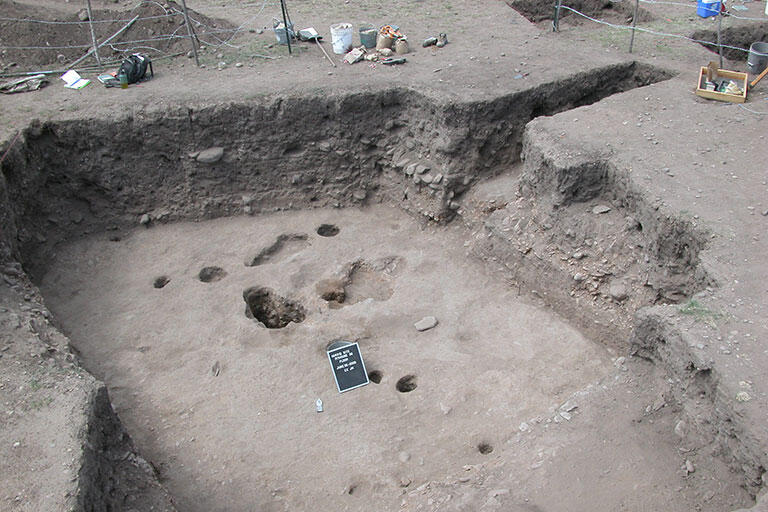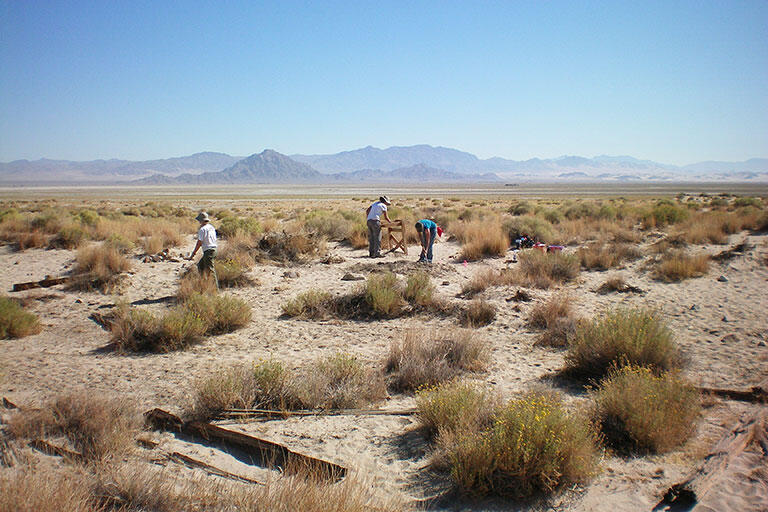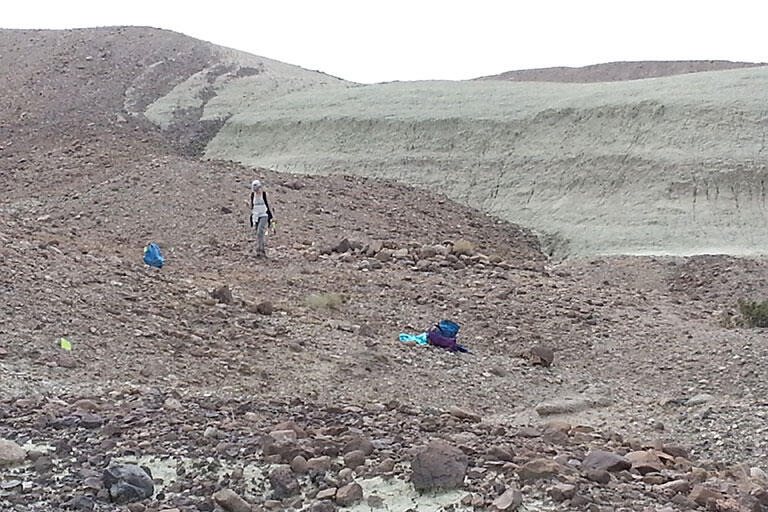
The research conducted in this lab currently focuses on the analysis of artifacts found at the Elk Ridge site, a Mimbres Classic period (AD 1000-1130) pueblo found in the Mimbres River Valley of southwestern New Mexico. We have excavated a total of 20 houses and numerous extramural features and we have all of the materials recovered from these houses in our lab. We have been analyzing all of the remains associated with daily activities including ceramic vessels, stone tools, and ground stone (used for food processing), along with specialty items such as ceramic and stone figurines and stone and shell jewelry. We are using these data to examine pueblo household organization and growth and development.
We are also continuing research on the Pithouse period (AD 550-1000) in the Mimbres region using data from the Harris Site and the Lake Roberts Vista site.
For further information or for research and educational opportunities, please contact Dr. Barbara Roth at barbara.roth@unlv.edu.
The Elk Ridge Ruin is a Mimbres Classic period (AD 1000-1130) pueblo located in the Mimbres River Valley in southwestern New Mexico. The site is the largest above-ground pueblo in the northern portion of the Mimbres Valley (we estimate 200 rooms). Excavations have been conducted by Barbara Roth, co-director Dr. Darrell Creel, and graduate and undergraduate students from UNLV.
We began working in the portion of the site owned by the U.S. Forest Service in 2015 because an arroyo cutting through the western part of the site was eroding several pueblo rooms. In four field seasons, we have excavated portions of 20 rooms (several of them superimposed), two ramadas, and numerous extramural features and burials. This has been an amazing opportunity to gain insights on pueblo construction and room use because of the opportunity to excavate unlooted rooms.
Our on-going research suggests that this site played an important role in inter-valley exchange and interaction. Our data suggest that it was a pottery production center, that people raised turkeys there, perhaps for trade to other villages, and that intermarriage with groups from outside the region was practiced.


The Harris Site, a Late Pithouse Period site located in the Mimbres Valley of southwestern New Mexico, was first excavated in the 1930s by Emil Haury. Data collected from Haury’s work at the Harris Site enabled him to define the Mogollon as a distinct cultural group in the Southwest (Haury 1936). Research at the Harris Site by the University of Nevada, Las Vegas, under the direction of Dr. Barbara Roth, had aimed to build on Haury’s foundation of research and enhance our understanding of Mimbres Mogollon lifeways during the Pithouse period (AD 550-1000).
Archaeological investigations at the Harris site focused on addressing household and community organization during the Pithouse period and the relationship between household organization, subsistence practices, and sedentism over time. This work was funded in part by a National Science Foundation grant to Dr. Roth. Craft production during the Pithouse period also became an important focus of our research, and several graduate students have been working on projects involving ceramic and lithic production at the site. These issues, particularly household organization and craft production during the Pithouse period, are underexplored in the Mimbres region.
We completed fieldwork at the site in 2013 and excavated a total of 20 pithouses, 34 extramural features, and portions of a Three Circle phase (AD 750-1000) great kiva. A final report on the excavations was completed in 2015 and we are currently working on a synthetic book on our excavations.
One of the major findings of the current research is that corporate group organization developed during the Three Circle phase (A.D. 750-1000) at the site. We identified clusters of pithouses with shared architectural and ceramic traits that we think are the early manifestations of extended family corporate groups. Other autonomous households are present at the site that were linked to the overall community but were distinct from the clustered pithouses. We are using a variety of analytical techniques to explore how these households interacted and the role of the great kivas and plazas in communal integration.


Prehistoric Forager Landscape Use in the Mojave Sink, Mojave Desert
Since 2006, Dr. Roth and her students have been conducting research along the shores of Soda Playa, a dry lake located in the Mojave Sink near Zzyzx, California and in Afton Canyon along the Mojave River. This research has focused on reconstructing prehistoric land use strategies in the Mojave Sink region.
Two UNLV-sponsored field schools have been done at two sites along the shores of Soda Playa – Soda Springs Rockshelter and the Mojave Delta Site. UNLV graduate and undergraduate students also participated in a survey on BLM land in Afton Canyon under the direction of Dr. Roth.
Soda Springs Rockshelter
Test excavations were done at Soda Springs Rockshelter, located next to Soda Springs on the west side of Soda Playa. These excavations were concentrated in midden deposits outside the rockshelter. The results supported previous work at the rockshelter by archaeologists from the University of California, Fullerton (Schroth 1982) and indicated that the site was used as a hunting and processing camp from as early as the Middle Archaic period through the Late Prehistoric period.
Roth, Barbara J. and Claude Warren
2008 On the Shores of Pleistocene Lake Mojave: Investigations at Soda Springs Rockshelter. In Proceedings of the 2007 Three Corners Conference, edited by M. C. Slaughter, S. Daron, E. Jensen, and K. A. Sprowl, pp. 211-226.


Mojave Delta Site
Test excavations were conducted at the Mojave Delta Site located in dunes along the southwestern shore of Soda Playa in the Fall of 2009. This research was supported by a Begole Archaeological Research Grant. Five features, primarily small hearths, were found along with a scatter of ground stone, lithics, and several ceramics. The results of these excavations indicated that the site was a plant procurement and processing site, most likely occupied during the spring to exploit spring annuals. It appears to be part of a complex of sites along the shore of Soda Playa that were used seasonally for different tasks during the Late Prehistoric period.
Graduate student Tiffany (Thomas) Arend completed her M.A. thesis on the Late Prehistoric occupation of Soda Playa, using a sample survey of the lake shore combined with excavation data from the field schools.
Arend, Tiffany and Barbara Roth
2015 Landscapes and Land Use along Soda Playa in the Mojave Desert. Journal of California Archaeology 7:175-204.
Roth, Barbara J.
2016 Gendered Landscapes and the Late Prehistoric Occupation of the Mojave Desert. In Native American Landscapes, An Engendered Perspective, edited by Cheryl Claassen, pp. 193-214. University of Tennessee Press.

Afton Canyon
This project involved survey of portions of the rim and plateau region above Afton Canyon. The primary goal of this project was to examine the use of the canyon rim to determine how the rim sites fit into regional subsistence and settlement patterns. The majority of the recovered sites were lithic scatters lacking temporal diagnostics. The other recorded sites document two different land use strategies in Afton Canyon – one represented by base camps located on dune sites next to the Mojave River, focused on generalized foraging activities along the river and the second representing more specialized land use for hunting big horn ship and lithic procurement.
Roth and several undergraduates are currently using survey to explore the use of hunting blinds in Afton Canyon using GIS to reconstruct access and lines of sight.

The Southwestern Archaeological Research lab has several graduate students affiliated with the lab where they conduct research projects and assist undergraduate students.